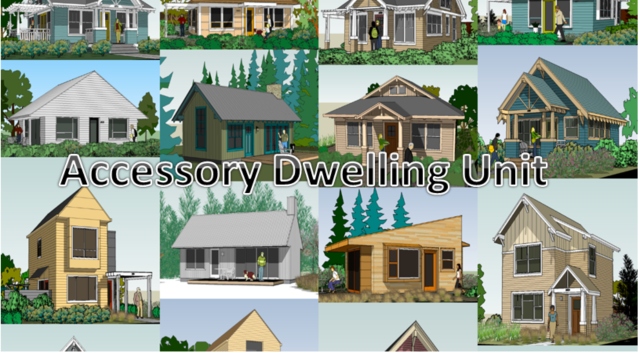
ADU – Accessory Dwelling Unit
What’s an ADU?
ADU is an acronym for Accessory Dwelling Unit. Also called: Granny Flat, Backyard Cottage, DADU (Detached Accessory Dwelling Unit) and other terms. Check your planning or zoning code for availability and current requirements, they’re frequently revised .
In the United States, secondary suites are technically referred to as accessory dwelling units or ADUs. An ADU is second complete dwelling unit which is legally built within or on the same lot as an existing single family residence. An ADU provides complete independent living facilities including a kitchen, bathroom and its own entryway. ADUs are typically not allowed to be sold separate from the primary home and the homeowners are usually required to reside in one of the two units. State laws typically delegate planning and zoning powers to city and county governments which specify the appropriate type, distribution and intensity of land uses in the local jurisdiction. As a result, the feasibility of building an accessory dwelling unit (ADU) (also known as a secondary suite, second unit, granny cottage, etc.) can vary widely from place to place, depending on state law and each local jurisdiction’s willingness to adopt regulations that facilitate ADUs.
Popular in the early 20th century, ADUs fell into disfavor after WWII, when a shift to suburban development occurred with emphasis on the nuclear family. However, with increases in the price of housing in many cities and suburbs, an increased awareness of the costs of low-density car-oriented development patterns and an increased need to care for the aging baby boom generation, ADUs have been promoted by some as a beneficial option. However, some critics perceive ADUs to be a threat to the character of single-family residential neighborhoods.
In California, Government Code Sections 65852.150, 65852.2 & 65852.22 pertain to local regulation of ADUs. SB 1069 and AB 2299 are California bills approved in 2016 and effective January 1, 2017, that limit local government authority to prohibit ADUs in certain cases (and also reduce cost and bureaucracy hurdles to construction).
Santa Cruz, California has an ADU program.
The County of Maui in Hawaii has an ADU program.
Honolulu, Hawaii, has “Ohana Dwelling Units,” which although similar to ADUs, limit occupancy to “family” and have other regulatory requirements. Ohana Dwellings in Hawaii were created as an allowed use in the zoning code in 1981 as a way to encourage the private sector to create more housing units (without government subsidy), preserve green fields (open space) and ease housing affordability. In 2015, Honolulu amended its zoning code to add a new use—ADUs—as a sort of Ohana Dwelling, but with fewer restrictions. To prevent creating further complexities for existing Ohana Dwellings, some of which have been condominimized and owned separately from the main house, Ohana Dwellings remain an allowed use (with different requirements and benefits than ADUs) in the zoning code. Due to the poor turnout in the number of ADUs, Honolulu added incentives in 2016, waiving permit fees. Fee waivers were extended in 2017. ADUs are an important component to Honolulu’s Affordable Housing Strategy.
On December 9, 2016 the Seattle Times mentioned proposed legislation to allow more and larger mother-in-law apartments and backyard cottages in neighborhoods zoned for single-family houses in Seattle.
What are the Area Limits for an ADU?
Every jurisdiction is different. Most freestanding ADUs are limited to a maximum area of around 800 sf. Another limit can be a percentage of the area of the primary residence. Note that the terminology and method of calculating permitted area varies by jurisdiction. Some building departments measure area to the face of an outer wall while others calculate area to the face of an inside wall or to the face of the foundation. Some refer to heated interior space. Check your planning or zoning code.
Are There Other Requirements for AN ADU?
Limits ON height and Lot Placement are the Common. S Some jurisdictions The require some kind of Compatibility with at The Primary Residence. S Some Dictate the What direction at The Front Door the MUST face. Requirements are Updated PERIODICALLY SO the Check for at The MOST Current.
The What are at The Benefits of AN ADU?
● the Provides Extra, Affordable, Housing ON Site Supporting Density and Sustainability Goals.
● Produces Income with A return ON Investment.
● Leverages existing Property Enhancing value.
● Facilitates “Aging-in-Place” AKA downsizing And “Generation Swap.”
